Flights to Australia Don’t Have to Cost an Arm and a Leg – Here’s How to Book Them Cheaply With Transferable Points
Signing up for credit cards through partner links earns us a commission. Terms apply to the offers listed on this page. Here’s our full advertising policy: How we make money.
Update: One or more card offers in this post are no longer available. Check our Hot Deals for the latest offers.
INSIDER SECRET: Some airlines allow you to book free stopovers on award flights. So it’s possible to add in a trip to Fiji or Hong Kong or somewhere else for no extra miles.
Whether you want to visit Australia for its incredible beaches, top-flight wineries, amazing wildlife or impressive historical narrative, miles and points can help you get there.
Unfortunately, flights to Australia aren’t always cheap . . . or easy. Even if you live in Texas or California and can fly non-stop, you’ll still face 14 to 16 hours of travel each way.
That’s why I recommend you redeem miles and points from one of the best credit cards for travel for your Australian vacation and maybe even splurge on business class.
Here’s how to use transferable points for award flights to Australia, including tips on how to use Chase Ultimate Rewards, Amex Membership Rewards, Marriott and Citi ThankYou points.
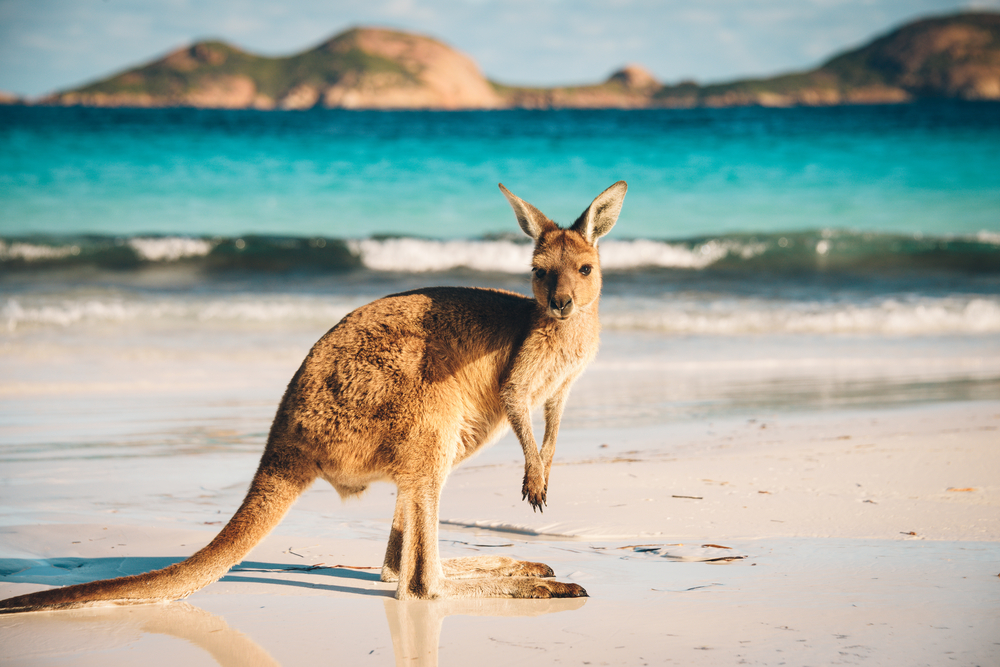
How to Book Flights to Australia With Transferable Points
To keep things simple, I’ll cover the best ways to fly in and out of Sydney. If you weren’t planning on visiting Sydney, you should add it to your list. After just a few nights at the Park Hyatt Sydney you’ll fall in love with the city, its gorgeous architecture and pristine beaches.
I won’t cover every option for every type of flexible rewards. Instead, I’ll review the most useful and practical transfer partners and the basics that will help you make an informed decision, like:
- Transfer ratio: How many points do you need to transfer to get the number of miles you need?
- Transfer time: How long does it usually take to transfer your points to the airline? This is important because you don’t want to find an award only to see it disappear while you’re waiting for the miles to show up in your account.
- Award Prices: How many miles will it take to book a flight to Australia with a particular airline?
- Partner Award Prices: You can use most airline miles to book award flights on their partner airlines. For example, you can use United Airlines miles to book award seats on Asiana. However, airlines typically have different award charts for their partner airlines. And partner award seats are usually harder to find. In many cases, you’ll only be able to book the lowest priced (i.e. Saver level) awards. Also, sometimes airlines don’t allow partner bookings for business- or first-class seats.
- Fuel Surcharges: When you book an award ticket, you’ll always have to pay for taxes and fees, which can be very high depending on where you’re going (i.e. London). But some airlines add fuel surcharges to the taxes and fees. This can add hundreds of dollars to the ticket cost. So I’ll let you know whether or not you can expect these types of charges with each particular airline.
- Pros: What are the reasons you’d want to transfer points to an airline?
- Cons: What are the downsides of transferring points to an airline?
- Other notes: If there are any special rules, tips, or ticks you should know for an airline, they’ll be covered here.
How to Get to Australia With Chase Ultimate Rewards Points
You can earn transferable Chase Ultimate Rewards points with the following cards:
- Chase Sapphire Preferred® Card
- Chase Sapphire Reserve®
- Ink Business Preferred Credit Card
And you can pool the Chase Ultimate Rewards points you earn with the following no-annual-fee cards onto the “premium” cards listed above and then transfer them to Chase’s travel partners:
- Chase Freedom®
- Chase Freedom Unlimited®
- Ink Business Cash℠ Credit Card
- Ink Business Unlimited℠ Credit Card
The information for the Chase Freedom has been collected independently by Million Mile Secrets. The card details on this page have not been reviewed or provided by the card issuer.
British Airways
British Airways operates a distance-based award chart, so British Airways Avios points aren’t always the most useful. Australia is so far from the continental US that using Avios points isn’t the best deal. And with British Airways, you’ll pay based on the distance of the flight segment, not the total flight distance. So shorter nonstop flights can be a good deal, but if you need a connecting flight you’ll pay extra for it.
Transfer ratio: 1:1
Transfer time: Instant
Award Prices: British Airways operates a distance-based award chart. You can use the Great Circle Mapper to estimate the distance of each segment of your flight.
| British Airways Avios Points Required for Each Flight | ||||
|---|---|---|---|---|
| Travel Distance | Coach | Premium Economy | Business Class | First Class |
| 1 to 650 miles | 6,000 | 9,000 | 12,500 | 24,000 |
| 651 to 1,151 miles | 9,000 | 12,500 | 16,500 | 33,000 |
| 1,152 to 2,000 miles | 11,000 | 16,500 | 22,000 | 44,000 |
| 2,001 to 3,000 miles | 13,000 | 25,250 | 38,750 | 51,500 |
| 3,001 to 4,000 miles | 20,750 | 41,250 | 62,000 | 82,500 |
| 4,001 to 5,500 miles | 25,750 | 51,500 | 77,250 | 103,000 |
| 5,501 to 6,50 miles | 31,000 | 62,000 | 92,750 | 123,750 |
| 6,501 to 7,000 miles | 36,250 | 72,250 | 108,250 | 144,250 |
| 7,000+ miles | 51,500 | 103,000 | 154,500 | 206,000 |
Partner Award Prices: British Airways uses the same chart for their awards and partner awards unless you book a flight with 2+ or more partner airlines. In that case, you’ll want to refer to this chart. You’ll notice that the prices aren’t good and the fees are hefty.
With almost all partner awards, you can only book the peak price.
With British Airways Avios points, you can book Qantas flights under 650 miles within Australia for 4,500 Avios points one-way + taxes & fees. Qantas and American Airlines fly nonstop to Australia from San Francisco, Los Angeles, and Dallas, but all of those flights are over 7,000 miles, so you’ll pay at least 50,000 British Airways Avios points plus taxes and fees for one-way award flights in coach.
Note: Also, as of May 30, 2019, British Airways is increasing the price of partner awards and flights over 7,000 miles will cost 51,500 Avios points. And short-haul flights under 650 miles will cost 6,000 Avios points.
Fuel Surcharges: Yes
Pros: Good for booking short-haul flights within Australia.
Cons: Not good for folks who can’t fly nonstop or need to fly farther to get to Australia. Higher fuel surcharges and fees on most flights.
Other notes: For more tips check out our complete guide to British Airways Avios points.
Iberia
Iberia operates a distance-based award chart, like British Airways. You can transfer Avios points between your Iberia & British Airways accounts but you’ll have to jump through a few hoops to do it.
Iberia is a member of the oneworld alliance, so you’ll be able to book partner award flights with Qantas and American Airlines. You can also book award flights to Australia by routing through Asia on Japan Airlines and Cathay Pacific. But that would make a very long journey even longer.
Transfer ratio: 1:1
Transfer time: Instant
Partner Award Prices: Iberia has a separate award chart for each of their partner airlines, although most are exactly the same. You’ll pay based on the total distance of the flight. And for most partners, you’re only allowed to book round-trip award flights.
If you are booking an award with more than one oneworld partner, then you’ll use the award chart below. And it is the same chart as the award charts for flights with American Airlines and Qantas, which are two of the more useful partners for flying to Australia.
Nonstop round-trip flights from the US to Australia will be between 14,000 to 18,000 miles in distance (ouch!), so I’ve highlighted those award prices.
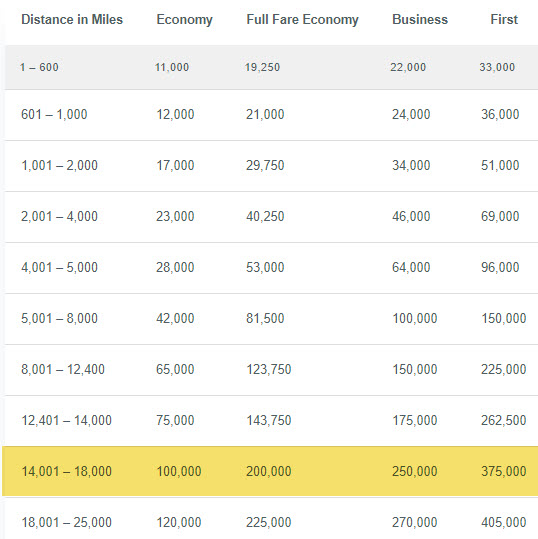
The best deals will be on the shortest flights, so you’ll want to look for nonstop flights on American Airlines or Qantas.
Fuel Surcharges: Yes, but certain partners, like American Airlines, don’t have fuel surcharges
Pros: Easy to earn – they transfer from Amex Membership Rewards, Chase Ultimate Rewards, Marriott, and British Airways.
Cons: Distance-based award charts are rough for flights to Australia because it is so far from the US. Some partner awards can only be booked over the phone (which incurs an extra fee). Partner awards are non-refundable
Other notes:
- You can book American Airlines partner awards online, but you’ll need to call to book partner awards with most other airlines.
Flying Blue (Air France / KLM)
Flying Blue is the rewards program of both Air France and KLM, and you can use Flying Blue miles to book travel to Australia on Delta.
Transfer Ratio: 1:1
Transfer Time: Instant
Award Prices: Flying Blue doesn’t publish an award chart anymore. Rather, they offer a pricing calculator to estimate the price between two cities. For your reference, the following prices are typically the lowest available:
- Coach – 48,500 Flying Blue miles one-way in coach from the US to Australia on Delta
- Business Class – 121,000 Flying Blue miles one-way in business class from the US to Australia on Delta
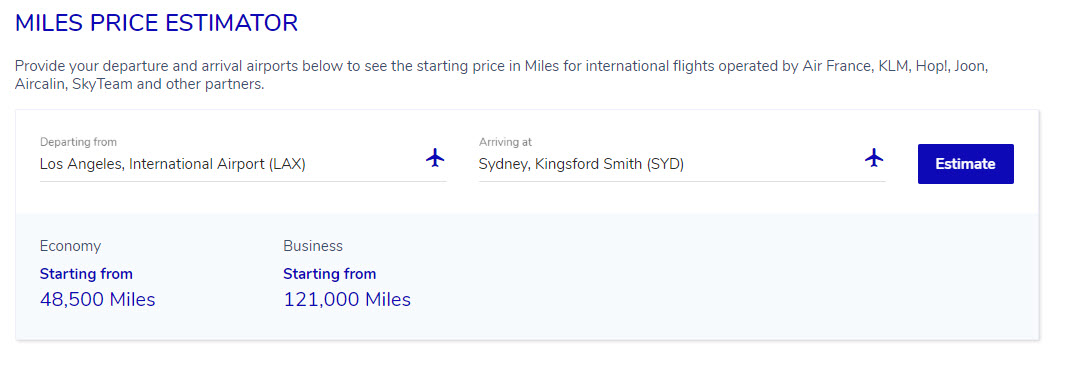 Fuel Surcharges: Flying Blue does pass on fuel surcharges on other flights, but Delta’s fees are reasonable and will cost ~$100 per person each way.
Fuel Surcharges: Flying Blue does pass on fuel surcharges on other flights, but Delta’s fees are reasonable and will cost ~$100 per person each way.
Pros: Even though the Flying Blue price calculator can be hit or miss, their award search engine does a pretty good job. The award calendar is a great bonus.
Cons: Can be tough to find available award seats on Delta, especially if you need to connect in the contiguous US.
Singapore Airlines miles are not particularly useful for getting to Australia. You will be better off booking nonstop flights with United Airlines miles, which I’ll detail below. The biggest advantage of Singapore Airlines miles is how easy they are to earn. You can transfer points from Citi ThankYou, Chase Ultimate Rewards, Amex Membership Rewards, Capital One and Marriott to Singapore Airlines.
So if you don’t have enough flexible points to get to Australia in any single program, you can easily combine points together and book award flights with Singapore Airlines miles.
Transfer ratio: 1:1
Transfer time: Up to two days
Award Prices: You could use Singapore Airlines to fly from the US to Australia, but it would require a lot of flying. For example, you could fly from Los Angeles to Tokyo to Singapore to Sydney, but that would take nearly two days of your vacation. And that routing would also cost a significant amount of miles. Instead, I would search for flights on United Airlines or Air New Zealand and look at Singapore Airlines Star Alliance partner award chart.
You’ll pay 60,000 Singapore Airlines miles for a one-way flight in coach from the US to Australia. And award flights in business or first class are even more outrageously priced at 130,000 miles and 167,500 miles, respectively.
That’s why I don’t recommend transferring Chase Ultimate Rewards to Singapore Airlines for award flights to Australia unless you need to combine points across multiple flexible currencies.
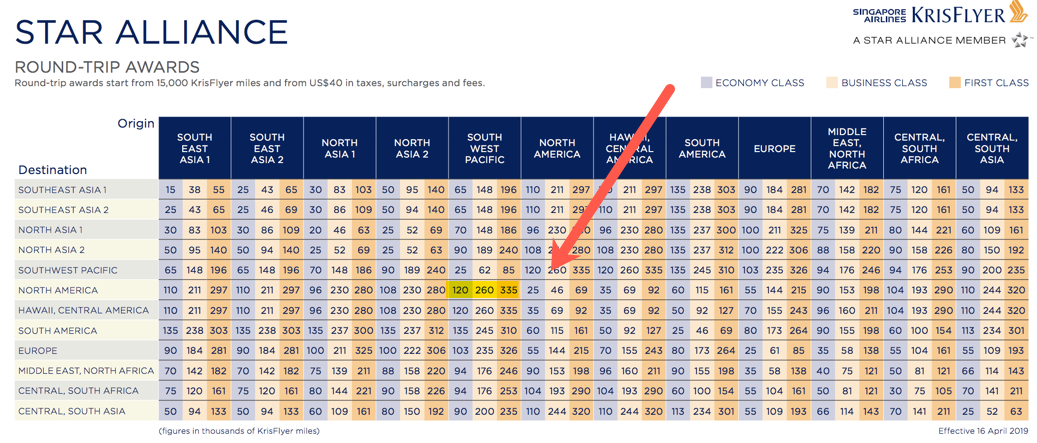
Fuel Surcharges: Singapore Airlines does not add fuel surcharges to their own flights. But if you’re booking a partner award flight, you’ll pay fuel surcharges when the airline you’re flying with has them. Most Asian airlines add hefty fuel surcharges. Others, like United Airlines, don’t have any fuel surcharges.
Pros: Some of the easiest airline miles to earn as they transfer from Chase Ultimate Rewards, Amex Membership Rewards, Citi ThankYou, Capital One and Marriott.
Cons: High cost of awards. You’re better off using United Airlines miles.
Other notes: You are allowed one stopover (layover of 24+ hours) and one “open-jaw” (origin or destination is not the same) on round-trip Saver award flights. You can add more stopovers on award flights for $100 each (up to three total), but you can’t book them online.
United Airlines
United Airlines used to be an excellent option for using Chase Ultimate Rewards points for award flights to Australia because ofthe program’s simplicity and available award seats. But as of November 15, 2019, United is getting rid of its award chart and will price award flights dynamically.
We don’t know exactly what that will mean for award prices in the short term. My guess is that you’ll be able to pick up good deals during the off-season and the prices will skyrocket during peak travel times. And in the long term it means that the cost of United Airlines award flights will be increasing, but we don’t know when or by how much.
Transfer ratio: 1:1
Transfer time: Instant
Award Prices:
- Coach – 40,000 United Airlines miles for a one-way Saver Award, up to 100,000 United Airlines miles for a one-way Everyday Award
- Business Class – 80,000 United Airlines miles for a one-way Saver Award, up to 200,000 United Airlines miles for a one-way Everyday Award
Partner Award Prices:
- Coach – 40,000 United Airlines miles one-way
- Business Class – 90,000 United Airlines miles one-way
- First Class – 130,000 United Airlines miles one-way
Fuel Surcharges: Thankfully, United Airlines does not add fuel surcharges for their award flights or partner award flights.
Pros: United Airlines awards are easy to find and book and typically there is pretty good award availability if you book in advance. (Remember that Australia’s high season runs from December to March, so it’ll be trickier to find award flights then and easier when it’s summer in the US.)
Cons: Business- and first-class partner awards and Everyday Awards are expensive.
Other notes:
- United Airlines charges a booking fee of $75 for award flights booked within 21 days of departure, but after November 15, 2019, United will be eliminating this fee.
- United Airlines allows a free stopover or a free one-way on round-trip award flights in the form of the “United Airlines Excursionist Perk.”
- If you have one of the Chase United Airlines credit cards or United Airlines elite status, you’ll have access to more available award seats.
- For more on how to book awards with United Airlines miles, check out our Ultimate Guide to United Airlines Miles.
Virgin Atlantic doesn’t fly to Australia, but they are worth mentioning because they partner with Virgin Australia. And you can fly nonstop from Los Angeles to Brisbane, Melbourne or Sydney using your Virgin Atlantic Miles.
Transfer ratio: 1:1
Transfer time: Instant
Award Prices: There are no Virgin Atlantic flights from the US to Australia
Partner Award Prices: Virgin Atlantic has a different award chart for each partner airline. You can check them out here. But the only useful partners for flights to Australia are Virgin Australia and Delta.
All the prices below are for round-trip awards.. You can book one-way award flights on Virgin Australia using your Virgin Atlantic miles.

These prices aren’t outrageous, but if you have Chase Ultimate Rewards, I recommend transfering them elsewhere. If you already have Virgin Atlantic miles and can find the available award seats (which is notoriously tough in business-class), this can be a viable option.
Award flights on Delta cost slightly more, but might be a better deal because Delta award seats are easier to find. The Delta section of Virgin Atlantic’s website doesn’t mention redeeming miles for award flights to Australia, but the cost of award flights has typically been as follows:
- 50,000 Virgin Atlantic miles for one-way in coach on Delta from the US to Australia
- 75,000 Virgin Atlantic miles for one-way in business class on Delta from the US to Australia
Although award flights on Delta look like a great deal (which they are), award seats on Delta flights can be difficult to find at the “Saver level” which is required to book with Virgin Atlantic miles.
Unfortunately, you cannot book partner award flights online. You’ll have to book them over the phone (800-365-9500).
Fuel Surcharges: Yes, but the fuel surcharges are reasonable, typically around ~$110 per person, each way.
Pros: You can transfer Chase Ultimate Rewards, Amex Membership Rewards, Citi ThankYou, and Marriott Virgin Atlantic – so they’re easy to earn.
Cons: Can’t search for or book partner awards online. Fuel surcharges on award flights.
Other notes:
- The easiest place to search for award flights on Virgin Australia is Delta.com, then call Virgin Atlantic to book the flights.
- Although award flights on both Virgin Australia and Delta are hard to find, Virgin Australia consistently releases award seats within five days of departure. So keep that in mind if you’re really flexible or don’t mind gambling with your dates.
When to Book Through the Chase Travel Portal Instead
Depending on how much your plane tickets cost, it doesn’t always make sense to transfer Chase Ultimate Rewards points to airline partners for award flights. Instead, you might save points by booking a cheap fare through the Chase Ultimate Rewards travel portal.
A decision on whether to book through Chase Travel will depend on a few things: How much the ticket costs, what transfer partner you would be using, and which Chase card(s) you have.
Let’s start out with which Chase card you have. Here’s what your points are worth through the portal with each Chase Ultimate Rewards card:
| Chase Ultimate Rewards Card | How Much Are Points Worth Toward Travel? |
|---|---|
| Chase Sapphire Reserve® | 1.5 cents |
| Chase Sapphire Preferred® Card | 1.25 cents |
| Ink Business Preferred® Credit Card | 1.25 cents |
| Ink Business Cash Credit Card | 1 cent |
| Ink Business Unlimited Credit Card | 1 cent |
| Chase Freedom® | 1 cent |
| Chase Freedom Unlimited® | 1 cent |
Generally, the cheaper your plane ticket is, the more it probably makes sense to redeem points through Chase travel instead of through a transfer partner.
Let’s look at a quick example. Suppose you were going to transfer miles to United Airlines to book a coach ticket. United Airlines charges 80,000 miles to fly to Australia found-trip in coach. You would be better off redeeming through the Chase Ultimate Rewards travel portal if your ticket cost less than the following:
- With the Chase Sapphire Reserve: $1,200
- With the Chase Sapphire Preferred or Ink Business Preferred: $1,000
- With other Chase cards: $800
Depending on what miles you are using, these numbers wouldn’t necessarily be the same. To find out what the breakeven price would be, take the numbers required and multiply by the value of your Chase points. For example, 40,000 United Airlines miles X 0.015 (for the Chase Sapphire Reserve) = $600.
Looking at it another way, let’s say that your round-trip flight to Australia was going to cost $900. This is how many points you would pay if you booked through the Chase Ultimate Rewards travel portal:
- With the Chase Sapphire Reserve: 60,000 Chase Ultimate Rewards points ($900/0.015)
- With the Chase Sapphire Preferred or Ink Business Preferred: 72,000 Chase Ultimate Rewards points ($900/0.0125)
- With other Chase cards: 90,000 Chase Ultimate Rewards points ($900/0.01)
In this case, you would be better off booking through the Chase Ultimate Rewards travel portal if you have the Chase Sapphire Reserve, Chase Sapphire Preferred, or Chase Ink Business Preferred rather than transferring and paying 80,000 United Airlines miles for an award ticket.
But remember that business-class flights will typically cost considerably more when paying cash, so redeeming miles will often be the better value. Especially if you can afford the extra miles, using Chase Ultimate Rewards to fly business class Down Under can make your long travel time much more comfortable.
To find out how many points you need for a given ticket price when booked through the Chase Ultimate Rewards travel portal, take the ticket price and divide by the value of your Chase points, depending on what Chase card you have. To use our example from above, $900/0.015 (for the Chase Sapphire Reserve) = 60,000 Chase Ultimate Rewards points.
Two other benefits to redeeming your points through the Chase Ultimate Rewards travel portal is that you don’t have to worry about finding available award seats or blackout dates. As long as there’s a seat available for sale, you will be able to book it and you’ll also earn frequent flyer miles and credit toward status for your airline ticket.
How to Get to Australia With Amex Membership Rewards Points
Amex Membership Rewards points are helpful for getting to most cities in Australia because, as you’ll see, they have lots of useful airline transfer partners and they are easy to earn.
If you’ve got a collection of Amex Membership Rewards points, I would focus on using your miles for flights on a Star Alliance airline. That’s because Amex Membership Rewards points transfer to ANA and Aeroplan (both Star Alliance members) at a 1:1 ratio. But one of the best things about Amex Membership Rewards points is the frequent transfer bonuses they have with their partner airlines.
Aeroplan is Air Canada’s loyalty program and is part of the Star Alliance. Aeroplan is also partners with Cathay Pacific, but you can only redeem Aeroplan miles on a few select Cathay Pacific routes, none of which will get you to Australia.
Overall, Air Canada Aeroplan offers very competitive award-flight prices to Australia. And because of their partnership with the other Star Alliance airlines, Air Canada Aeroplan award availability for flights Down Under is some of the best out there.
Transfer ratio: 1:1
Transfer time: Instant
Award Prices: A round-trip flight to Australia costs 90,000 Air Canada Aeroplan miles in coach, 135,000 Air Canada miles in premium economy, 160,000 Air Canada miles in business class, and 220,000 Air Canada miles in first class.

One-way awards cost half of the Air Canada Aeroplan miles required for round-trip flights.
Partner Award Prices: Aeroplan doesn’t have a separate award chart for partner awards, but they partner with useful airlines for getting to Australia, such as United Airlines & Asiana.
Fuel Surcharges: Yes, but not with all of their partners. If you want to avoid these extra fees, try booking partner-award flights with United Airlines.
Pros: Visit extra cities for free via stopovers. Lots of useful partner airlines. Frequent transfer bonuses.
Cons: Fuel surcharges on some flights. Routing to Australia via Asia can make for a very long travel day.
Other notes:
- You’re allowed two stopovers or one stopover and one open-jaw on award flights between two continents
- Reasonable lap-infant fees – $50 to $125 or 5,000 to 12,500 Aeroplan miles
- For more tips, check out our guide to using Aeroplan miles
ANA
ANA (All Nippon Airways) is one of the best options for award flights to Australia. They have incredible award prices on ANA flights and good partner-award-chart prices as well.
The biggest drawbacks are how complicated and confusing ANA’s award charts and rules are, along with potentially higher taxes and fees on award flights. I’ll keep things as simple as possible by only including information that is relevant to award flights to and from Australia.
Transfer ratio: 1:1
Transfer time: two to three days
Partner Award Prices:
Flights from North America to Australia with ANA vary in price depending on whether your flights are on ANA or one of their Star Alliance partners.
In the chart below, Y is coach, C is business class, and F is first class. You can only book round-trip international awards:

ANA has the same Star Alliance partners as Air Canada Aeroplan and United Airlines, but you’ll pay less if you can find flights on ANA. Round-trip award flights between the US and Australia on one of ANA’s partner airlines cost 75,000 ANA miles in coach, 120,000 ANA miles in business class, and 225,000 ANA miles in first class.
You cannot book one-way partner award flights, so all the prices listed are for round-trip tickets only, and there is only one award chart for the entire year.
ANA Award Prices: Round-trip award flights from the US to Australia on ANA, however, cost 65,000 ANA miles in coach, 110,000 ANA miles in business class, and 210,000 ANA miles in first class.
Fuel Surcharges: Yes, and they can go up to ~$450 (plus taxes & fees), but you won’t pay this extra fee with certain partners like United Airlines.
Pros: Amazing award prices, lots of partner airlines.
Cons: Must book round-trip award flights. Confusing and convoluted rules. The extra fees can add up
Other notes:
- ANA miles expire after 36 months and cannot be extended.
- You can have one stopover and one open-jaw on award flights.
It’s not uncommon for there to be an Amex Membership Rewards transfer bonus to British Airways. And they can be quite generous, which could make British Airways a useful option.
Transfer ratio: 1:1
Transfer time: Instant
For more details on using British Airways Avios points to get to Australia, check the Chase Ultimate Rewards points section.
Cathay Pacific operates a distance-based award chart. They are a member of the oneworld alliance, which includes American Airlines and Qantas.
Cathay Pacific’s award program is fairly convoluted and tricky, so I don’t recommend it for most people. But if you can find award seats on Qantas, Asia Miles are actually quite valuable for flights between the US and Australia.
Transfer ratio: 1:1
Transfer time: one to two days
Award Prices: For flights on Qantas between Australia and the US, you’ll pay 40,000 Asia Miles one-way in coach, 50,000 Asia miles one-way in premium economy, 75,000 Asia miles one-way in business class, and 120,000 Asia miles one-way in first class.
If you want to fly with one of Cathay Pacific’s other partner airlines, you can calculate the mileage for your award here. In general, your best bet will be award flights on Qantas.
Partner Award Prices: The most useful Cathay Pacific partners for getting to Australia are American Airlines and Qantas. Most folks would rather avoid connecting in Cathay Pacific’s Hong Kong hub when traveling between the US and Australia.
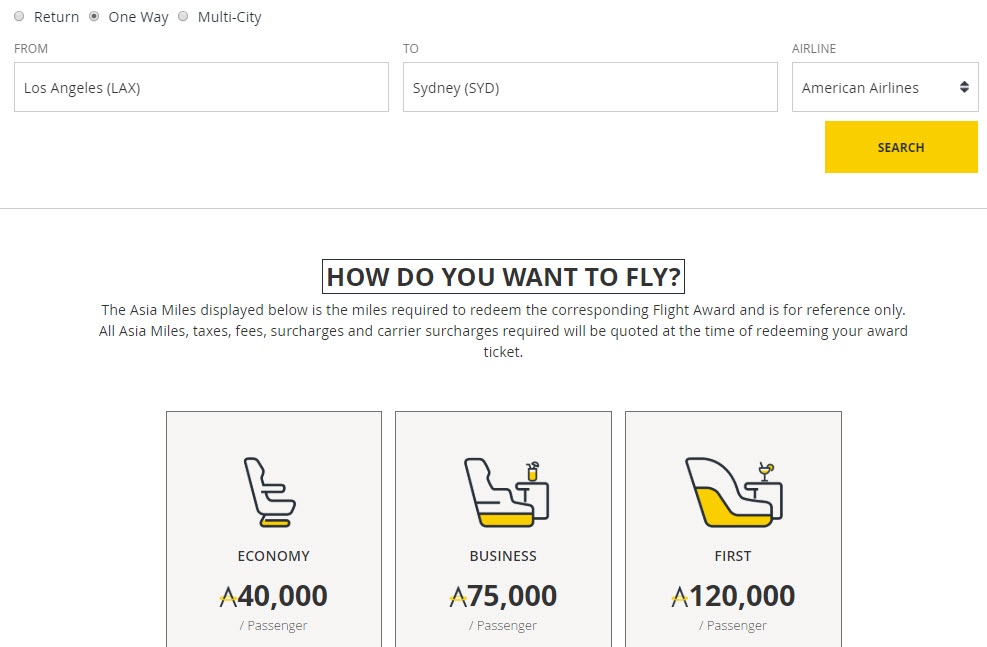
If you are booking an award which includes only one partner airline or one partner airline and Cathay Pacific or Cathay Dragon, then you’ll use the “Asia Miles Standard Award” chart. A Standard Award round-trip award flight can have up to three stopovers and one open-jaw, but the rules are complicated and this doesn’t apply to all award flights. You can read more about the stopover and open-jaw rules under #5 in the terms.
The oneworld multi-carrier chart applies if your award flight includes:
- Two oneworld partner airlines, but does not include Cathay Pacific or Cathay Dragon
- Three or more oneworld partner airlines and Cathay Pacific or Cathay Dragon is one is one of those airlines
For oneworld multi-carrier flights, the stopover and open-jaw policy looks like it could be even more generous, but I can’t easily figure it out, and in any event, I’m not sure how practical it is for most flights to Australia.
Fuel Surcharges: Yes, but certain airlines don’t add them (like American Airlines).
Pros: Easy to earn – they transfer from Amex Membership Rewards, Citi ThankYou, Capital One and Marriott. Useful for short-haul or one-way awards. Potentially generous stopover and open-jaw policy.
Cons: Expensive award prices. Overly complicated. The most useful partners (for getting to Australia) don’t release many award seats.
Other notes:
- You can book award flights online if you’re flying on Cathay Pacific, Cathay Dragon, Alaska Airlines, British Airways, Finnair, Iberia, Qantas, or Qatar Airways. But for awards which include any other partner airline you’ll need to fill out a “Flight Award Request Form“ or call 866-892-2598 to book your award.
- Use this tool to figure out how much a specific award flight will cost.
- Sometimes you’ll get a phone agent who doesn’t completely understand Cathay Pacific’s convoluted award-booking rules. Don’t be afraid to hang up and call again.
Delta no longer publishes an award chart. So it’s a guessing game to estimate how many Delta miles it will cost to get to Australia.
But Delta does have frequent award flash sales. So it’s good to keep an eye out for a good deal. I’ve seen award flights on sale to Sydney for 50,000 Delta miles round-trip.
Transfer ratio: 1:1
Transfer time: Instant
Award Prices: Delta doesn’t have an award chart, but I found one-way coach flights starting at 40,000 Delta miles and one-way business class award seats starting at . . . 430,000 Delta miles. Yeah, Delta’s prices can quickly get out of control.
Partner Award Prices: No partner award chart, but partner awards to Australia are difficult to find and typically only available on Virgin Australia.
Fuel Surcharges: Yes, but not on Delta flights originating in the US.
Pros: Potentially useful award sales.
Cons: No award chart. Fewer nonstop flight options compared to other airlines. Outrageous pricing at times
Other notes:
- Delta’s had award flight sales between the US and Australia for as few as 50,000 Delta miles round-trip. Keep an eye out for future award sales.
Hawaiian Airlines
Hawaiian Airlines has terrible award prices for flights from the US to Australia. They also don’t have any nonstop flights to Australia and you aren’t allowed a stopover in Hawaii, which is the only reason I’d want to connect in Hawaii on my way to Australia. In addition, it’s very difficult to find low-level award flights.
That said, there have been transfer bonuses to Hawaiian Airlines in the past, so that could make this a more interesting opportunity, but only if you want to top up your Hawaiian Airlines account for an award flight.
Transfer ratio: 1:1
Transfer time: Instant
Award Prices: The prices listed in the chart below are for one-way award tickets. A one-way flight in coach starts at 60,000 Hawaiian Airlines miles and can be as high as 270,000 miles from the East Coast. That’s insane.

Partner Award Prices: Hawaiian Airlines partners with Virgin Australia and while the prices aren’t great, they are better than what it would cost to fly to Australia on Hawaiian Airlines. Here are the round-trip prices:
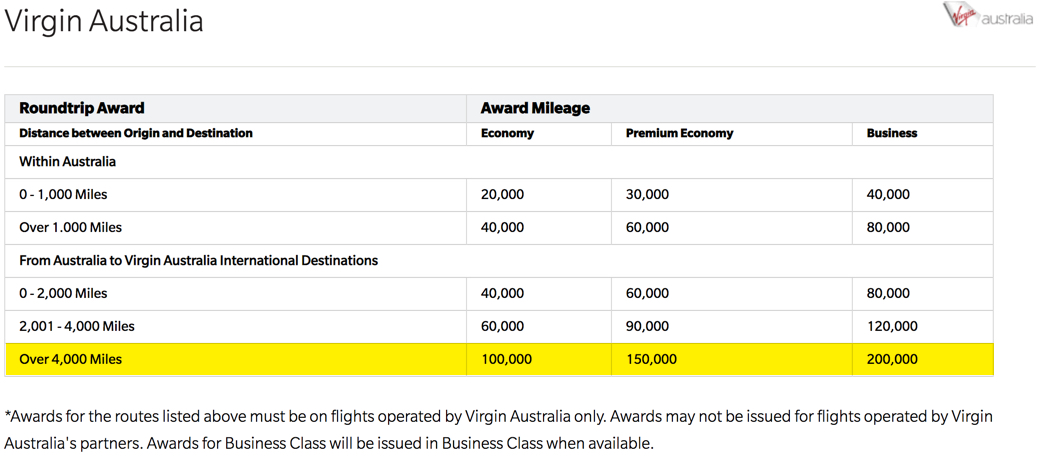
Fuel Surcharges: No
Pros: Low fees.
Cons: No stopovers in Hawaii. Absolutely terrible award prices.
Other notes:
- This is only a useful option if you already have a collection of Hawaiian Airlines miles and only need to transfer some Amex Membership Rewards points over to top off your account, or if you live in Hawaii.
- You can use Hawaiian Airlines miles for award flights on Virgin Australia, but you’d have to book round-trip and a flight in coach would cost 100,000 Hawaiian Airlines miles. I would pass on this option, because you might be able to use Delta to book the same award flights for less.
Iberia operates a distance-based award chart, just like British Airways. And you can even transfer Avios points between your Iberia and British Airways accounts.
Iberia is a member of the oneworld alliance, so you’ll be able to book partner-award flights with Japan Airlines, American Airlines, Qantas, and Cathay Pacific.
Transfer ratio: 1:1
Transfer time: one to two days
For more details on using Iberia Avios points to get to Australia, check the Chase Ultimate Rewards points section.
Singapore Airlines miles are not particularly useful for getting to Australia. But they are easy to earn. You can transfer points from Citi ThankYou, Chase Ultimate Rewards, Amex Membership Rewards, Capital One and Marriott to Singapore Airlines.
So if you don’t have enough flexible points to get to Australia in any single program, you can easily combine points together and book award flights with Singapore Airlines miles.
See the Singapore Airlines notes under the Chase Ultimate Rewards section for more details.
Transfer ratio: 1:1
Transfer time: Up to 24 hours
Virgin Atlantic doesn’t fly to Australia, but they are worth mentioning because they have decent award-flight prices for travel on their partner airline, Virgin Australia. Plus, Virgin Atlantic miles are super easy to collect because they partner with four transferable points currencies.
You’ll also frequently see transfer bonuses to Virgin Atlantic, making them even easier to earn.
Transfer ratio: 1:1
Transfer time: one to two days
See the Virgin Atlantic notes under the Chase Ultimate Rewards section for more details.
LifeMiles is the mileage program for Star Alliance member Avianca, and often has big sales for folks interested in purchasing LifeMiles. This might work out if you’re OK spending some cash on your trip, but we prefer to transfer points and miles to save money.
Avianca offers fair award pricing to Australia, but also has good award availability due to their partnership airlines. Because United Airlines is also part of Star Alliance, you can redeem Avianca miles for travel on United Airlines.
Transfer ratio: 1:1
Transfer time: Instant
For more details on using Avianca LifeMiles to book flights to Australia see the Avianca section under Citi ThankYou points.
Etihad has different award prices for each partner, which can make things pretty complicated. If you want to use Etihad miles to fly to Australia, I recommend focusing on award flights on American Airlines (because the award flight prices on Virgin Australia and Air New Zealand are considerably higher).
Transfer ratio: 1:1
Transfer time: Instant
For details on how to use Etihad miles to book flights to Australia see the Etihad section under Citi ThankYou points.
When to Book Through the Amex Travel Portal Instead
It doesn’t always make sense to transfer Amex Membership Rewards points to airline partners for award flights. Instead, you might save points by booking through Amex Travel.
Whether or not it makes sense to book through Amex Travel will depend on a couple of things: How much the ticket costs, what transfer partner you would be using, and possibly on what Amex card you have.
Usually the Amex card that you have won’t make a difference as to how much your points are worth. For most cards, your Membership Rewards points are worth just one cent each when redeemed for airfare. But, there’s one exception:
If you have The Business Platinum Card® from American Express, you’ll get 35% of your redeemed points back in two cases: If you’re booking business- or first-class airfare on any airline through amextravel.com, or if you’re booking coach on your airline of choice (the same airline that you’ve chosen to get the up to $200 airline fee-credit reimbursement from). In these cases, your Amex points are worth ~1.54 cents each when you factor in the rebate.
Generally, the cheaper your plane ticket is, the more likely it makes sense to redeem points through Amex Travel instead of through a transfer partner.
How to Get Flights to Australia With Citi ThankYou Points
Citi ThankYou points are another great option for award flights to Australia. Like Chase Ultimate Rewards and Amex Membership Rewards points, they have a number of useful airline transfer partners (and some of the partners overlap). You can earn Citi ThankYou points from cards like the Citi Premier℠ Card.
LifeMiles is the mileage program for Star Alliance member Avianca and often has big sales for folks interested in purchasing LifeMiles. This might work out if you’re OK with spending some cash on your trip but we prefer to transfer points and miles to save money.
Avianca offers fair award pricing to Australia, but also has good award availability thanks to their partnership airlines. Because United Airlines is also part of Star Alliance you can redeem Avianca miles for travel on United Airlines.
Transfer ratio: 1:1
Transfer time: Instant
Award Prices: Avianca splits the US up into regions: United States 1, United States 2, and United States 3. However, for flights between the US and Australia, it doesn’t matter where you are flying from or to — the prices are the same. If you want to fly in coach (X), it costs 40,000 Avianca miles each way, Business Class (I) costs 80,000 Avianca miles each way and First Class (O) costs 111,000 Avianca miles each way.
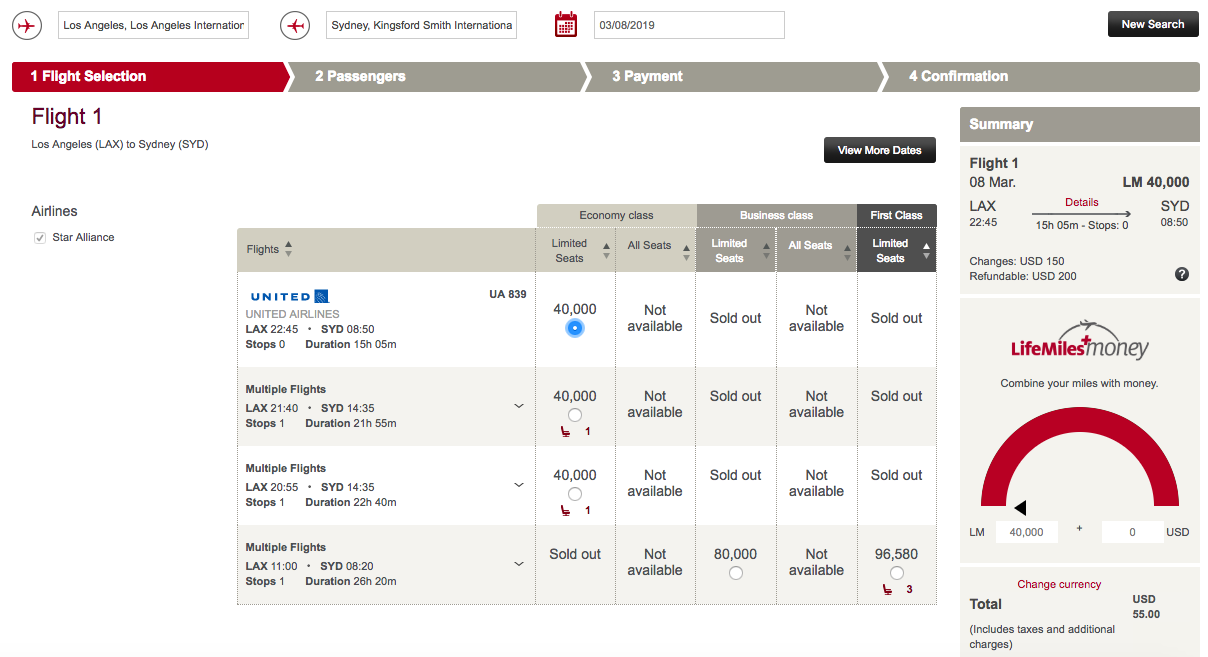
Note: LifeMiles award prices differ for flights in first class and business class depending on the length of each sector in each cabin.
These award prices are very reasonable, and comparable to other Star Alliance award charts. Some folks prefer this option because they would rather save their United Airlines miles or Air Canada Aeroplan miles for other bookings.
Fuel Surcharges: Low—typically not more than ~$100 one way per person.
Pros: Good award flight prices. Solid number of available award flights.
Cons: Sometimes shows “phantom” award flights. If you have issues with your ticket, Avianca phone agents often aren’t helpful.
Other notes: Avianca charges a $25 fee for all award bookings.
Cathay Pacific Asia Miles
Cathay Pacific Asia Miles is also a Citi ThankYou transfer partner. They operate on a distance-based award chart, and therefore offer poor value on the long flights Down Under.
Transfer ratio: 1:1
Transfer time: Instant
For more information on using Asia Miles to get to Australia, check out the Amex Membership Rewards section of this post.
Etihad has different award prices for each partner, which can make things pretty complicated. If you want to use Etihad miles to fly to Australia, I recommend focusing on award flights on American Airlines (because the award flight prices on Virgin Australia and Air New Zealand are considerably higher).
Transfer ratio: 1:1
Transfer time: Instant
Award Prices: Etihad’s award prices between the US and Australia on American Airlines are excellent, but available award seats can be hard to find. Business- and first-class awards are particularly attractive, but those are the toughest award flights on which to find open seats.
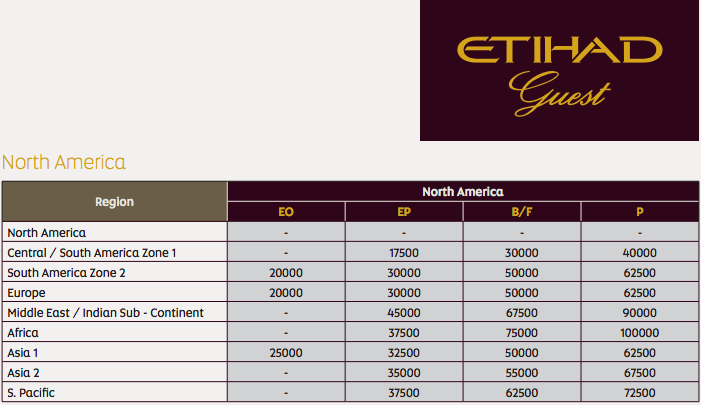
For a one-way flight from the US to Australia, you’ll pay 37,500 Etihad miles in coach, 62,500 Etihad miles in business class, or 72,500 Etihad miles in first class. Each of these represents a great value — you’ll be more limited by finding available award seats than anything else.
Fuel Surcharges: Very low on flights on American Airlines.
Pros: Competitive award pricing.
Cons: Tough to find award flights. Frustrating that you cannot book online.
Other notes: I recommend searching for award flights at AA.com and then calling Etihad Guest to book. Happy hunting.
Flying Blue (KLM/Air France)
Flying Blue (Air France/KLM) is a transfer partner of all of the major transferable point currencies, and is a decent option for flights to Australia.
Transfer ratio: 1:1
Transfer time: Instant
To find out more about using Flying Blue miles to get to Australia, reference the Chase Ultimate Rewards section of this post.
Qantas
Qantas isn’t a bad program to work with and they have a really good award search engine. But because they have a distance-based award chart, flights between the US and Australia are fairly expensive.
Transfer ratio: 1:1
Transfer time: Instant
Award Prices: Qantas has a distance-based award chart. If you’re flying from the US to Australia, most flights are going to be around 7,000 to 10,000 miles in length each way, depending on where in the US you are flying from and how many connections you need to make. This means that your one-way flights are likely going to fall into Zone 8 or Zone 9.
Only Zone 8 pricing is really worth considering, and even then, only in coach. In most cases, you’ll want to book award flights to Australia with an airline that offers region-based award pricing. For one-way award flights from the US to Australia, expect to pay at least 45,000 Qantas points in coach, 72,000 Qantas points in premium economy, 96,000 Qantas points in business class, and 144,000 Qantas points in first class.
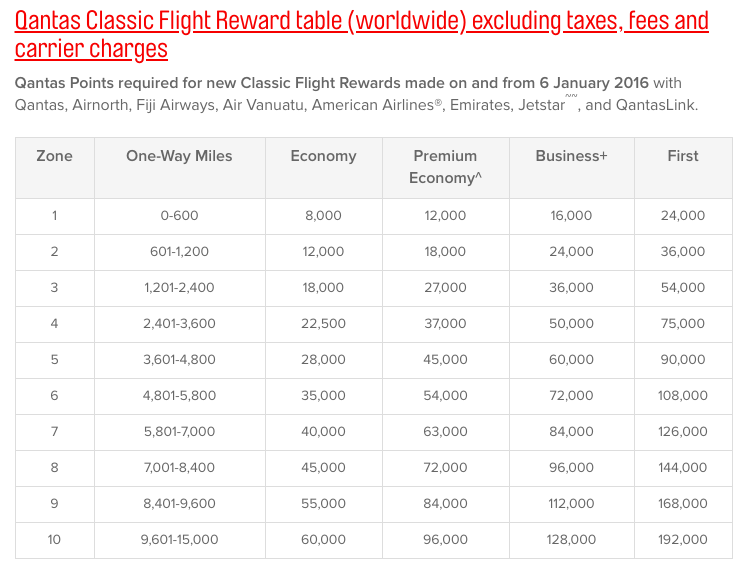
You can check the approximate distance of your flights on with the Great Circle Mapper and compare the cost of booking with Qantas and booking with Etihad if you want to fly American Airlines.
For example, here are some one way flight distances to Australia:
- Los Angeles (LAX) – Sydney (SYD): 7,490 miles one way
- San Francisco (SFO) – Melbourne (MEL): 7,860 miles one way
- Dallas (DFW) – Sydney (SYD): 8,580 miles one way
- New York (JFK) – Los Angeles (LAX) – Brisbane (BNE): 9,630 miles one way
Fuel Surcharges: Reasonable on award flights.
Pros: Great award search engine. OK award price in coach in certain circumstances (for example, a nonstop flight from the US to Australia).
Cons: High prices for business class and first class.
Singapore Airlines is a transfer partner of all of the major transferable point currencies.
Transfer ratio: 1:1
Transfer time: Instant
To find out more about using Singapore Airlines miles for flights to Australia, refer to the Chase Ultimate Rewards section of this post.
Virgin Atlantic is a transfer partner of all of the major transferable point currencies. They sometimes have access to more Delta award seats than other partners, so they may be worth a look if you’re coming up short elsewhere.
Transfer ratio: 1:1
Transfer time: Instant
For more information on using Virgin Atlantic miles to fly to Australia, refer to the Chase Ultimate Rewards section of this post.
When to Book Through the Citi ThankYou Travel Portal Instead
Depending on how much your plane ticket costs, it doesn’t always make sense to transfer Citi ThankYou Points to airline partners for award flights. Instead, you might save points by booking a cheap fare through the Citi ThankYou Travel Portal (and earn miles when you fly).
Whether or not it makes sense to book through the Citi ThankYou Travel Portal will depend on a few things: How much the ticket costs, what transfer partner you would be using (and the points price of your potential award ticket), and which Citi card(s) you have.
Let’s start out with which Citi card you have. Things are simpler here than with Chase and Amex. If you have the Citi Prestige or the Citi Premier Card, your ThankYou points are worth 1.25 cents each toward airfare (after September 1, 2019, Citi Prestige cardholders get 1 cent per point). If you have any other card that earns Citi ThankYou points, your points are worth 1 cent each.
Generally, the cheaper your plane ticket is, the more likely it makes sense to redeem points through the Citi ThankYou Travel Portal instead of through a transfer partner.
Let’s look at a quick example. Suppose you were going to transfer miles to Etihad to book a round-trip coach ticket on American Airlines. Etihad would charge 75,000 miles for this ticket. You would be better off redeeming through the Citi Travel Center if your ticket cost less than the following:
- With the Citi Prestige or Citi Premier: $937.50 (75,000 X 0.0125)
- With other Citi cards: $750 (75,000 X 0.01)
Depending on what miles you are using, these numbers wouldn’t necessarily be the same. To find out what the breakeven price would be, take the number of miles required and multiply by the value of your Citi points. For example, 75,000 Etihad miles X 0.0125 (for the Citi Prestige or Citi Premier) = $937.50.
Looked at another way, let’s say that your round-trip flight to Australia was going to cost $825. This is how many points you would pay if you booked through the Citi ThankYou travel portal:
- With the Citi Prestige or Citi Premier: 66,000 Citi ThankYou points ($825/0.0125)
- With other Citi cards: 82,500 Citi ThankYou points ($825/0.01)
In this case, you would be better off booking through the Citi Travel Portal if you have the Citi Prestige or Citi Premier, compared to transferring and paying 75,000 Etihad miles for an award ticket. If you have other Citi cards, it would cost less to transfer.
There are two other benefits to redeeming your points through the Citi ThankYou Travel Portal: First, you don’t have to worry about finding available award seats or blackout dates. As long as there’s a seat available for sale, you will be able to book it. Second, you’ll also earn frequent-flyer miles and credit toward status for your airline ticket.
How to Get to Australia With Marriott Points
There have been a lot of changes made to the Marriott Bonvoy rewards program as a result of the Marriott-Starwood merger. The transfer partners that used to be available to Marriott members and the transfer partners that were available to Starwood members are now all available in the new Marriott Bonvoy program.
And there are even two new airlines that weren’t available to either Starwood or Marriott in their previous rewards programs. Overall, there are 40+ airline partners available if you have Marriott points.
I won’t go into details about how to fly to Australia with every single possible partner. Instead, I’ll discuss the Marriott transfer partners that I like best for travel Down Under. Here’s our guide to transferring Marriott points to airlines.
Marriott points aren’t your only option for transferring to Air Canada Aeroplan. You can also transfer American Express Membership Rewards points.
Transfer ratio: 3:1 with a 5,000-mile bonus for transfers in increments of 60,000 Marriott Rewards points
Transfer time: ~5 days
To find out more about using your Air Canada Aeroplan miles to get to Australia, check out the Amex Membership Rewards section.
Alaska Airlines
Alaska Airlines miles are a solid option for getting to Australia on partner airlines such as American Airlines, Qantas, Fiji Airways and Cathay Pacific. But there are cheaper ways to book award flights on American Airlines, and you’ll probably want to avoid flying with Cathay Pacific because you would need to travel via Hong Kong.
Additionally, Alaska Airlines isn’t a partner of any other transferable point currency, so its miles are a little bit harder to earn than some of the other options. Nevertheless, if you can find award space on Qantas, Alaska Airlines miles are super valuable.
Transfer ratio: 3:1 with a 5,000-mile bonus for transfers in increments of 60,000 Marriott Rewards points
Transfer time: ~2 days
Award Prices: Alaska Airlines charges different award prices for each partner. Depending on whether you want to fly on American Airlines, Cathay Pacific, Fiji Airways or Qantas, you’ll have to look at different award charts and pricing.
Alaska Airlines charges the following numbers of Alaska Airlines miles for award flights to Australia:
- Coach: 40,000 miles for travel on American Airlines, Fiji Airways or Cathay Pacific, 42,500 miles for travel on Qantas.
- Premium Economy: 47,500 miles for travel on Cathay Pacific or Qantas. (Premium economy awards on American Airlines are not currently available for booking on this route.)
- Business Class: 80,000 miles for travel on American Airlines, 60,000 miles for travel on Cathay Pacific, and 55,000 miles for travel on Qantas or Fiji Airways.
- First Class: 110,000 miles for travel on American Airlines, 80,000 miles for travel on Cathay Pacific, and 70,000 miles for travel on Qantas.
As you can see, prices on Qantas are the best of the three options, but you’ll probably find more award seats on Cathay Pacific or American Airlines flights. And if you want to stop over in Hong Kong, traveling the long way through Asia might not be so bad. Or you could add in a free stopover in Fiji.
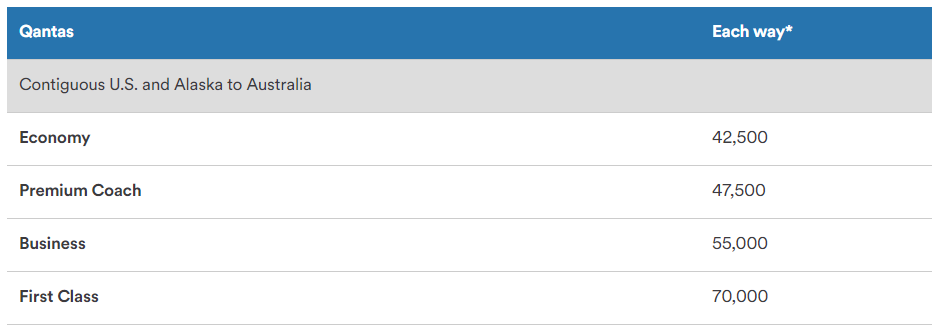
Fuel Surcharges: No
Pros: Excellent award pricing for “premium cabin.” Ability to stop over on a one-way award flight.
Cons: Relatively tough miles to earn.
Other notes:
- One of the best things about Alaska Airlines miles is the ability to do a stopover on a one-way award ticket. This means if you are flying Cathay Pacific, you could stop over in their hub, Hong Kong. If you’re flying American Airlines, you could spend a day or two in Los Angeles or another American Airlines hub on your way to Australia. If you book your return flight with Alaska Airlines miles, you can have another stopover on your return itinerary.
All Nippon Airways (ANA)
ANA is a great option for flights to Australia, but their fees and fuel surcharges can sometimes be quite high. They are also a transfer partner of Amex Membership Rewards, giving you an option to pool your miles.
Transfer ratio: 3:1 with a 5,000-mile bonus for transfers in increments of 60,000 Marriott Rewards points
Transfer time: ~7 days
The award chart and routing rules are relatively complicated, but if you want to find out more, check out the Amex Membership Rewards section of this post.
American Airlines
You can use American Airlines miles to book flights on Air Tahiti Nui, American Airlines, Fiji Airways and Qantas to get to Australia. Coach prices are pretty good, especially if you are traveling during off-peak times, but we generally wouldn’t recommend booking business class or first class with American Airlines miles unless you don’t have other options.
Note that American Airlines has three different price levels for travel to Australia: MilesSAAver, Anytime Level 1, and Anytime Level 2. Anytime Level 1 and 2 prices are not a good deal. Don’t book them.
Transfer ratio: 3:1 with a 5,000-mile bonus for transfers in increments of 60,000 Marriott Rewards points
Transfer time: ~2 days
Award Prices: Booking flights with American Airlines miles to Australia can be a decent value and award flights cost about the same as many of American Airlines’ competitors.
Regardless of which airline you travel on, low-level flight awards will cost:
- 40,000 American Airlines miles one-way in coach
- 80,000 American Airlines miles one-way in Business Class
- 110,000 American Airlines miles one-way in First Class
Coach prices are pretty reasonable, but I recommend transferring your Marriott points elsewhere if you want to fly in a premium cabin.
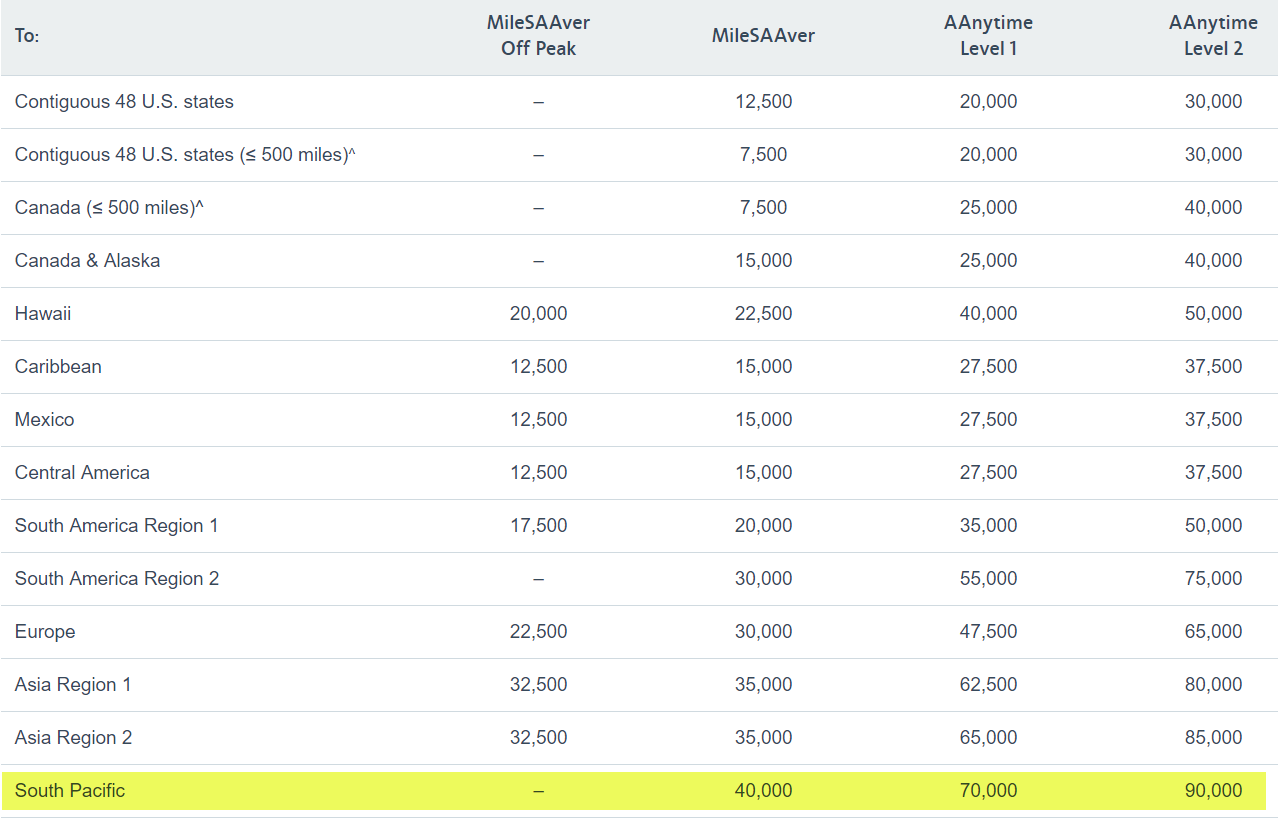
Fuel Surcharges: None on flights to Australia
Pros: Decently priced award chart. Multiple partner award options.
Cons: High business-class and first-class prices. Difficult to find SAAver award availability.
Other notes: Searching for award flights on partner airlines is complicated and sometimes requires calling in.
Avianca
Avianca miles can be a valuable option for award flights to Australia on United Airlines. Plus, Citi ThankYou points, Capital One miles and Amex Membership Rewards points also transfer to Avianca miles.
Transfer ratio: 3:1 with a 5,000-mile bonus for transfers in increments of 60,000 Marriott Rewards points
Transfer time: Up to 24 hours
For more information on using Avianca miles to fly to Australia, visit the Citi ThankYou Point section of this post.
British Airways presents a decent option for award flights to Australia if you can find nonstop award flights. This option is most useful for folks on the West Coast or Dallas who can find nonstop flights that work with their schedule.
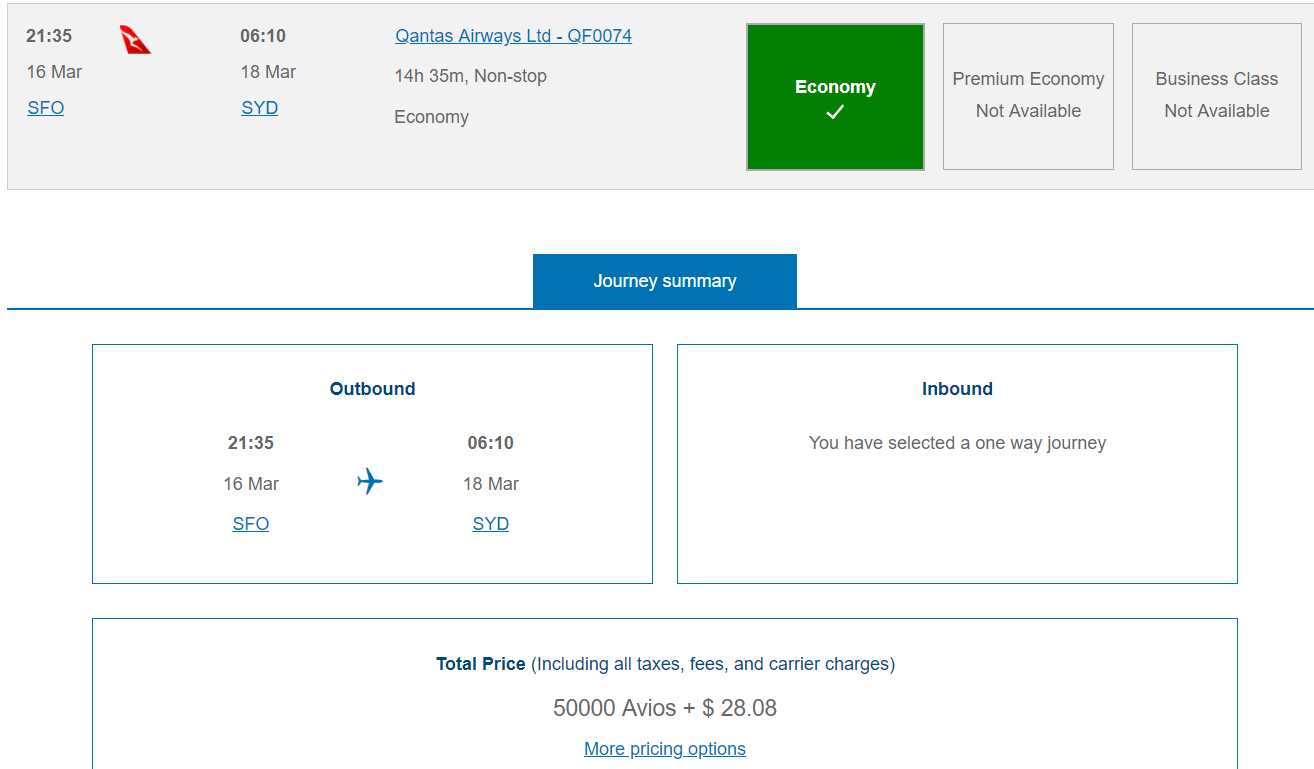
Transfer ratio: 3:1 with a 5,000-mile bonus for transfers in increments of 60,000 Marriott Rewards points
Transfer time: Under 24 hours
For more information on redeeming British Airways Avios points for flights to Australia, check out the Chase Ultimate Rewards section.
The Cathay Pacific Asia Miles award chart is one of the more complex charts out there. But, if you’re willing to put in some extra time, there is great value to be had.
Transfer ratio: 3:1 with a 5,000-mile bonus for transfers in increments of 60,000 Marriott Rewards points
Transfer time: ~10 days
For more information on redeeming Cathay Pacific Asia Miles for your Australian adventure, see the Amex Membership Rewards section.
Delta doesn’t publish an award chart anymore, so it can be difficult to know if you’re getting the lowest price possible. Nevertheless, they do occasionally offer award sales for flights to Australia which means your miles will go a lot further.
Transfer ratio: 3:1 with a 5,000-mile bonus for transfers in increments of 60,000 Marriott Rewards points
Transfer time: ~2 days
For more information on using Delta miles to fly to Australia, check out the Amex Membership Rewards section.
Etihad
We’ve already covered Etihad in the Citi ThankYou points section of this post, and they’re a great option if you can find award seats on American Airlines or if you need to combine points from multiple programs.
Transfer ratio: 3:1 with a 5,000-mile bonus for transfers in increments of 60,000 Marriott Rewards points
Transfer time: ~5 days
To find out more about using Etihad miles to get to Australia, visit the Citi ThankYou points section of this post.
Flying Blue (KLM/Air France)
KLM/Air France Flying Blue miles offer a decent option for award flights to Australia, but award prices are fairly high. Additionally, you’ll probably have a tough time finding low-level award seats.
On the other hand, Flying Blue is also transfer partners with Chase Ultimate Rewards, Amex Membership Rewards, Capital One and Citi ThankYou points, giving you great ability to combine miles from multiple programs.
Transfer ratio: 3:1 with a 5,000-mile bonus for transfers in increments of 60,000 Marriott Rewards points
Transfer time: ~1 day
If you want to read about using Flying Blue miles to fly to Australia, visit the Chase Ultimate Rewards section of this post.
Iberia offers a distance-based award chart which can be very valuable if you have relatively short flights (even if they involve a connection). But because of the long distances to fly to the South Pacific, Iberia isn’t my favorite transfer partner when Marriott has so many other choices.
Iberia is also a transfer partner of Chase Ultimate Rewards and Amex Membership Rewards, giving you the opportunity to combine your points.
Transfer ratio: 3:1 with a 5,000-mile bonus for transfers in increments of 60,000 Marriott Rewards points
Transfer time: ~6 days
If you want to find out more about using Iberia Avios points to get to Australia, visit the Amex Membership Rewards section of this post.
Lufthansa
Lufthansa miles are a pretty useful option for United Airlines flights to Australia. Like United Airlines, they are a member of Star Alliance. Unfortunately, Lufthansa miles aren’t that easy to earn because they are not a transfer partner of any of the other major transferable point currencies.
Transfer ratio: 3:1 with a 5,000-mile bonus for transfers in increments of 60,000 Marriott Rewards points
Transfer time: ~6 days
Award Prices: Lufthansa has a zone-based award chart, and award prices from the US to Australia start at 80,000 Lufthansa miles round-trip in coach. Business-class awards cost 135,000 Lufthansa miles and first-class awards cost 210,000 Lufthansa miles for round-trip bookings. One-way award bookings are allowed and cost half of a round-trip booking.
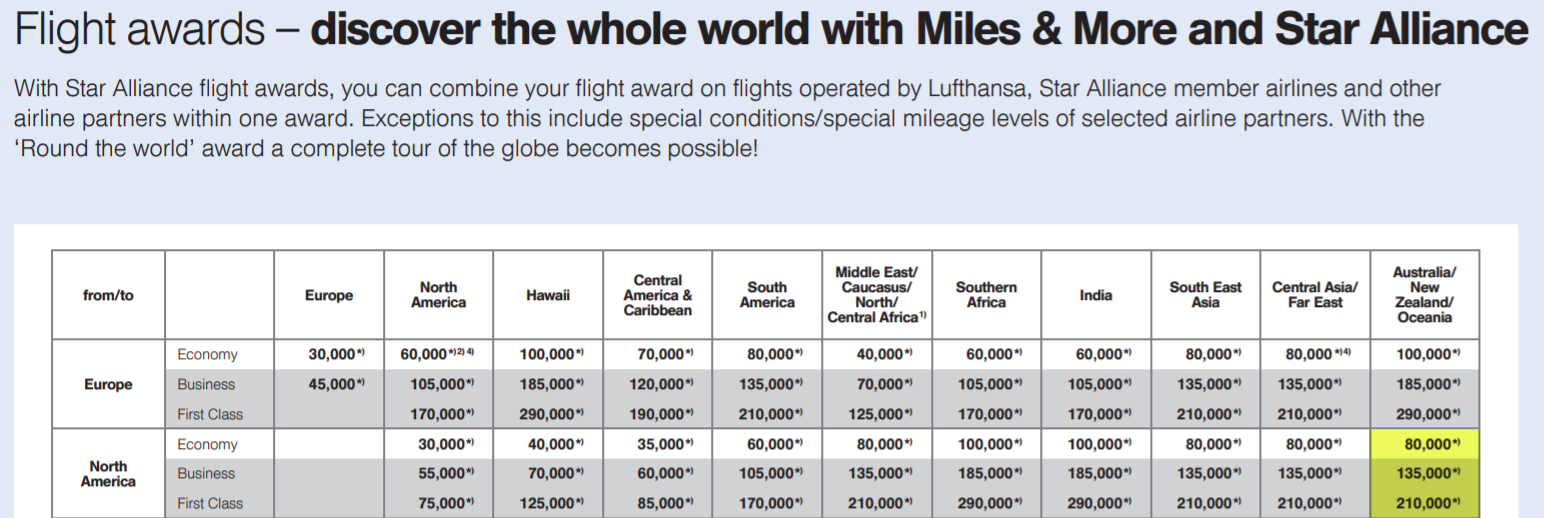
Fuel Surcharges: None on flights to Australia
Pros: Reasonable coach and business-class award prices. One-way bookings allowed
Cons: Relatively difficult to earn.
Other notes:
- Lufthansa allows two stopovers on round-trip awards, which can be incredibly helpful if you want to see a few different Aussie cities.
Qantas
Qantas also offers a distance-based award chart and has one of the best award search engines for oneworld flights. They’re not going to be the best award option for everyone, but in certain circumstances they can be.
Transfer ratio: 3:1 with a 5,000-mile bonus for transfers in increments of 60,000 Marriott Rewards points
Transfer time: ~6 days
To find out more about using Qantas points to get to Australia, read the Citi ThankYou point section.
Singapore Airlines is a decent option for flights to Australia, made even better by the fact that they are a transfer partner of Chase Ultimate Rewards, Amex Membership Rewards, Capital One and Citi ThankYou points, in addition to Marriott Rewards.
Transfer ratio: 3:1 with a 5,000-mile bonus for transfers in increments of 60,000 Marriott Rewards points
Transfer time: ~6 days
To find out more about using Singapore Airlines miles to get to Australia, check out the Chase Ultimate Rewards section of this post.
United Airlines
As I mentioned above, United Airlines miles are probably my favorite option for booking award flights to Australia. United Airlines’ award search engine is straightforward and you generally won’t have too much trouble finding available award seats, as long as you’re a little bit flexible.
Transfer ratio: 3:1.1 with a 5,000-mile bonus for transfers in increments of 60,000 Marriott Rewards points. So if you transfer 60,000 Marriott points to United Airlines, you’ll end up with 27,000 United Airlines miles.
Transfer time: Under 24 hours
If you want to find out more about using United Airlines miles to fly to Australia, visit the Chase Ultimate Rewards section of this post.
Virgin Atlantic miles are a great way to gain access to Delta award flights to Australia (if you can find low-level award seats). Virgin Atlantic is a transfer partner of Chase Ultimate Rewards, Amex Membership Rewards, and Citi ThankYou points in addition to Marriott Rewards.
Transfer ratio: 3:1 with a 5,000-mile bonus for transfers in increments of 60,000 Marriott Rewards points
Transfer time: Under 24 hours
For more information on using Virgin Atlantic Miles to get to Australia, visit the Chase Ultimate Rewards section of this post.
Bottom Line
Although Australia is on many travel wish lists, the long time to get there, different seasons, and expensive flights can make the trip halfway around the globe prohibitive. But by using your Chase Ultimate rewards, Amex Membership Rewards, Citi ThankYou, Capital One miles or Marriott points, you can save big or even fly in style.
Keep in mind that award flights can be tough to find, and sometimes you’ll be better off buying your flights through the Chase Ultimate rewards portal, Amex Travel, or the Citi ThankYou portal, especially if you can find reasonably priced coach flights.
Have you been to Australia? How did you pay for your flights?
For the latest tips and tricks on traveling big without spending a fortune, please subscribe to the Million Mile Secrets daily email newsletter.
Editorial Note: We're the Million Mile Secrets team. And we're proud of our content, opinions and analysis, and of our reader's comments. These haven’t been reviewed, approved or endorsed by any of the airlines, hotels, or credit card issuers which we often write about. And that’s just how we like it! :)

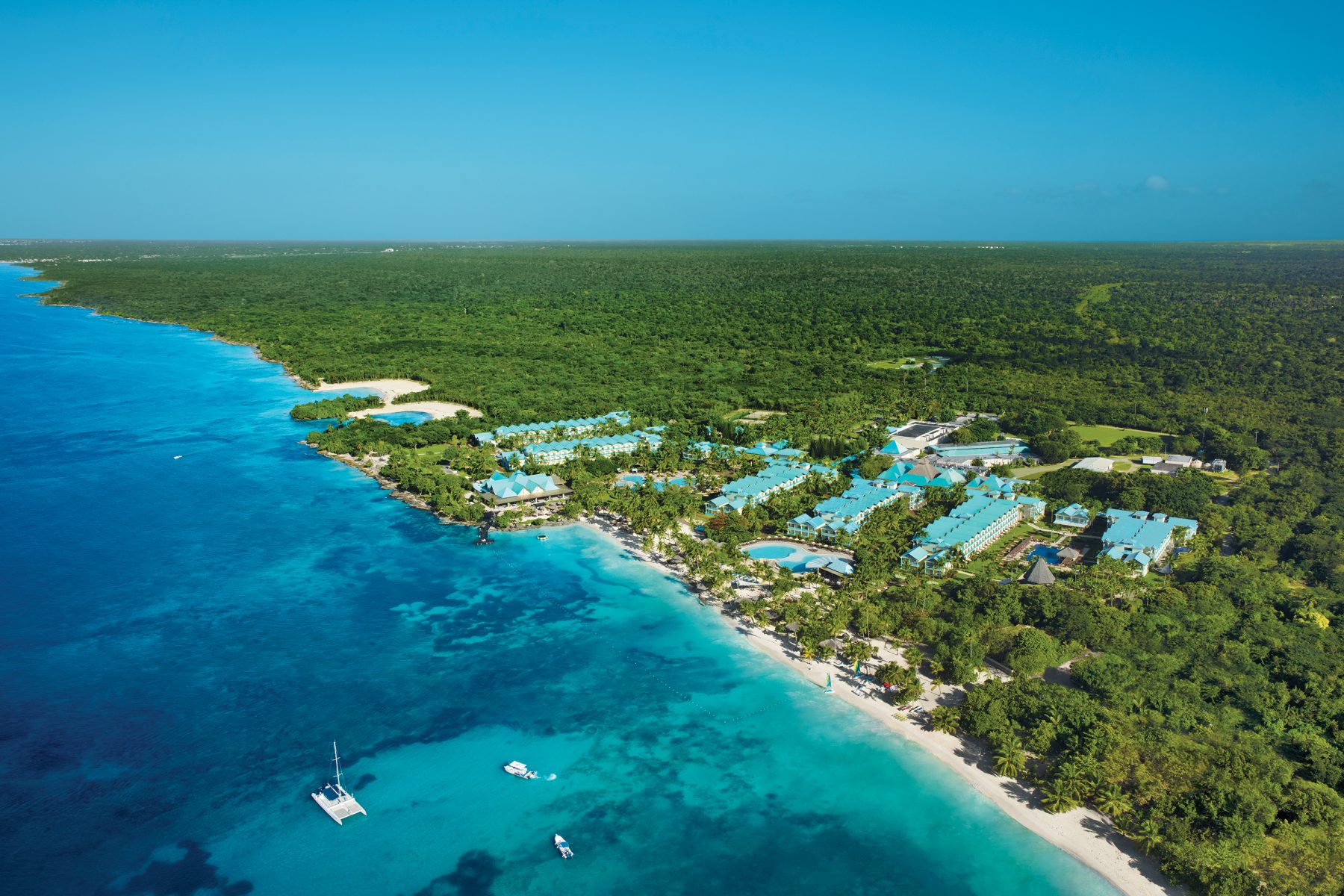




Join the Discussion!